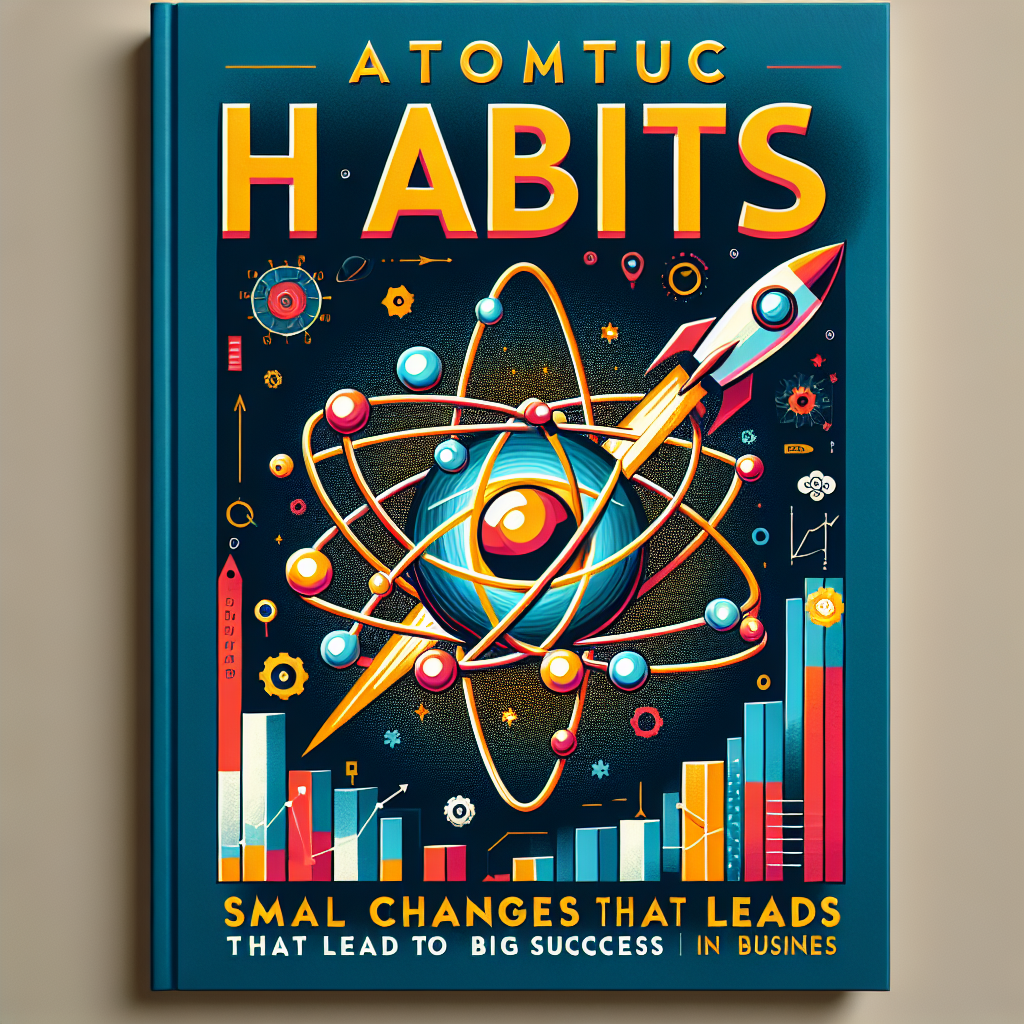
Building Consistency: How Atomic Habits Can Transform Your Business Routine
In the fast-paced world of business, achieving success often seems like a monumental task. However, the concept of ”Atomic Habits,” popularized by James Clear, suggests that small, consistent changes can lead to significant results over time. This idea is particularly relevant when it comes to building consistency in your business routine. By focusing on tiny, incremental improvements, you can create a solid foundation for long-term success.
To begin with, it’s essential to understand that habits are the building blocks of our daily routines. They shape our actions and, ultimately, our outcomes. In a business context, developing positive habits can lead to increased productivity, better decision-making, and enhanced overall performance. For instance, consider the habit of starting your day with a clear plan. By dedicating just a few minutes each morning to outline your priorities, you set a focused tone for the day, which can significantly boost your efficiency.
Moreover, the power of atomic habits lies in their simplicity and ease of implementation. Unlike drastic changes that can be overwhelming and unsustainable, small habits are manageable and can be seamlessly integrated into your existing routine. For example, if you aim to improve your communication skills, you might start by dedicating five minutes each day to practice active listening during meetings. Over time, this small habit can lead to more effective interactions and stronger relationships with colleagues and clients.
Another critical aspect of building consistency through atomic habits is the concept of habit stacking. This technique involves linking a new habit to an existing one, making it easier to remember and execute. For instance, if you already have a habit of checking your emails first thing in the morning, you could stack a new habit of reviewing your daily goals immediately afterward. This approach leverages the power of existing routines to create a seamless transition to new, productive behaviors.
Furthermore, tracking your progress is a vital component of maintaining consistency. By keeping a record of your habits, you can monitor your development and stay motivated. Simple tools like habit trackers or journaling can provide valuable insights into your progress and help you identify areas for improvement. For example, if you notice that you consistently struggle with time management, you can adjust your habits accordingly, perhaps by setting specific time blocks for different tasks.
In addition to tracking, it’s crucial to celebrate small wins along the way. Recognizing and rewarding your progress, no matter how minor, can reinforce positive behaviors and keep you motivated. For instance, if you’ve successfully implemented a new habit of taking short breaks to recharge during the workday, acknowledge this achievement and treat yourself to something enjoyable. This positive reinforcement can create a virtuous cycle of continuous improvement.
Lastly, it’s important to remember that building consistency through atomic habits requires patience and persistence. Change doesn’t happen overnight, and setbacks are a natural part of the process. However, by staying committed to your small, incremental improvements, you can gradually transform your business routine and achieve remarkable results. For example, if you encounter a particularly challenging period, remind yourself of the progress you’ve made and the long-term benefits of your efforts.
In conclusion, the concept of atomic habits offers a powerful framework for building consistency in your business routine. By focusing on small, manageable changes, leveraging habit stacking, tracking your progress, celebrating small wins, and maintaining patience and persistence, you can create a solid foundation for long-term success. Embracing these principles can lead to significant improvements in productivity, decision-making, and overall performance, ultimately transforming your business for the better.
The Power of Tiny Gains: Leveraging Small Changes for Business Growth
In the fast-paced world of business, the quest for success often feels like a race to achieve monumental goals. However, the concept of ”Atomic Habits,” popularized by James Clear, suggests that the path to significant achievements is paved with small, consistent changes. This idea, known as the power of tiny gains, can be a game-changer for businesses looking to grow and thrive. By focusing on incremental improvements, companies can create a culture of continuous development that leads to substantial long-term success.
To begin with, the principle of tiny gains is rooted in the idea that small, consistent actions compound over time. Just as a single drop of water can eventually carve out a canyon, minor adjustments in business practices can lead to remarkable transformations. For instance, consider the impact of improving a process by just 1% each day. While this may seem negligible at first, the cumulative effect over a year can result in a nearly 38% improvement. This compounding effect is the essence of atomic habits, where the focus is on making small, manageable changes that are sustainable over the long haul.
Moreover, implementing tiny gains in a business setting requires a shift in mindset. Instead of aiming for drastic overhauls, companies should identify areas where minor tweaks can yield significant benefits. This could involve streamlining workflows, enhancing customer service, or optimizing marketing strategies. By breaking down larger goals into smaller, actionable steps, businesses can maintain momentum and avoid the burnout that often accompanies ambitious projects. This approach not only makes goals more attainable but also fosters a sense of accomplishment and motivation among employees.
Transitioning to the practical application of atomic habits, it is essential to recognize the role of consistency. Consistency is the glue that holds these small changes together, ensuring that they become ingrained in the company’s culture. For example, a business might decide to implement a daily stand-up meeting to improve communication and collaboration among team members. While the immediate impact may be minimal, the regularity of these meetings can lead to better alignment, quicker problem-solving, and a more cohesive team over time. Consistency transforms these small actions into habits, which then become the foundation for sustained growth.
Furthermore, leveraging the power of tiny gains also involves measuring progress and celebrating milestones. Tracking improvements, no matter how small, provides valuable feedback and reinforces the importance of these incremental changes. Celebrating milestones, even minor ones, can boost morale and encourage continued effort. For instance, if a company sets a goal to increase customer satisfaction by 1% each month, acknowledging each month’s progress can motivate the team to keep pushing forward. This positive reinforcement creates a virtuous cycle where small wins lead to greater confidence and further improvements.
In addition, the concept of tiny gains can be applied to personal development within the business context. Encouraging employees to adopt atomic habits in their professional lives can lead to enhanced productivity and job satisfaction. Simple practices such as dedicating a few minutes each day to learning a new skill or organizing one’s workspace can have a profound impact over time. When individuals grow, the organization as a whole benefits, creating a ripple effect that drives overall business success.
In conclusion, the power of tiny gains lies in the ability to make small, consistent changes that compound over time, leading to significant business growth. By shifting the focus from monumental goals to manageable actions, companies can create a culture of continuous improvement. Consistency, measurement, and celebration of progress are key elements in this approach, ensuring that these small changes become ingrained habits. Ultimately, embracing atomic habits can transform the way businesses operate, paving the way for sustained success and long-term growth.
Habit Stacking: Integrating Atomic Habits into Your Daily Business Practices
In the fast-paced world of business, the quest for success often feels like a relentless pursuit of monumental achievements. However, the concept of ”atomic habits,” popularized by James Clear, suggests that small, incremental changes can lead to significant results over time. One effective strategy for integrating these atomic habits into your daily business practices is through habit stacking. This method involves linking new, beneficial habits to existing routines, making it easier to incorporate them into your day without feeling overwhelmed.
To begin with, consider the power of starting small. When you aim to implement a new habit, it can be tempting to go all out and make drastic changes. However, this approach often leads to burnout and inconsistency. Instead, focus on making tiny adjustments that are easy to maintain. For instance, if you want to improve your email management, start by dedicating just five minutes each morning to sorting through your inbox. Over time, this small habit can evolve into a more efficient and organized email system.
Next, identify your existing routines and find opportunities to stack new habits onto them. This technique leverages the power of context and consistency, making it easier to remember and perform the new habit. For example, if you already have a habit of drinking coffee every morning, you could use this time to review your daily goals. By linking the new habit of goal-setting to your established coffee routine, you create a seamless transition that requires minimal effort.
Moreover, it’s essential to recognize the cumulative effect of these small changes. While each individual habit may seem insignificant on its own, their combined impact can be substantial. Think of it as compounding interest in a savings account; small, consistent deposits grow into a significant sum over time. In the context of business, consistently practicing good habits like punctuality, effective communication, and proactive problem-solving can lead to a more productive and successful work environment.
Additionally, habit stacking can be tailored to fit various aspects of your business operations. For instance, if you’re looking to enhance team collaboration, you might stack a brief daily check-in meeting onto your existing morning routine. This practice can foster better communication and alignment among team members, ultimately leading to improved project outcomes. Similarly, if you aim to boost your professional development, consider stacking a habit of reading industry-related articles during your lunch break. This way, you can stay informed and continuously learn without disrupting your workflow.
Furthermore, it’s important to track your progress and celebrate small wins along the way. Keeping a record of your habits can provide valuable insights into what’s working and what needs adjustment. Celebrating milestones, no matter how minor they may seem, can also boost motivation and reinforce the positive behavior. For example, if you’ve successfully maintained a new habit for a week, reward yourself with a small treat or a break. This positive reinforcement can help solidify the habit and encourage continued effort.
In conclusion, integrating atomic habits into your daily business practices through habit stacking is a powerful strategy for achieving long-term success. By starting small, leveraging existing routines, and recognizing the cumulative impact of these changes, you can create a more efficient and productive work environment. Tailoring habit stacking to different aspects of your business and tracking your progress can further enhance the effectiveness of this approach. Ultimately, these small, consistent changes can lead to significant improvements and set the foundation for sustained success in your business endeavors.
Overcoming Procrastination: Using Atomic Habits to Boost Productivity
Procrastination is a common hurdle that many professionals face, often leading to stress and decreased productivity. However, the concept of atomic habits, popularized by James Clear, offers a practical solution to this pervasive issue. By focusing on small, incremental changes, individuals can gradually build habits that significantly enhance their productivity and overall success in business.
To begin with, it’s essential to understand that procrastination is not merely a matter of poor time management or laziness. It often stems from deeper psychological factors such as fear of failure, perfectionism, or feeling overwhelmed by the magnitude of a task. Recognizing these underlying causes is the first step toward addressing procrastination effectively. This is where atomic habits come into play, providing a structured approach to making small, manageable changes that can lead to substantial improvements over time.
One of the core principles of atomic habits is the idea that small changes, when consistently applied, can compound into significant results. For instance, instead of trying to overhaul your entire work routine overnight, you might start by dedicating just five minutes each day to a task you’ve been avoiding. This small commitment is less intimidating and more achievable, making it easier to get started. Over time, as this habit becomes ingrained, you can gradually increase the duration and complexity of the task, ultimately leading to greater productivity.
Moreover, the concept of habit stacking can be particularly effective in overcoming procrastination. Habit stacking involves linking a new habit to an existing one, creating a chain of behaviors that naturally flow from one to the next. For example, if you already have a habit of checking your email first thing in the morning, you could stack a new habit of spending the next five minutes planning your day. This approach leverages the momentum of your existing routines, making it easier to incorporate new, productive behaviors.
Another valuable strategy is to focus on the environment in which you work. Atomic habits emphasize the importance of designing your environment to support your desired behaviors. This might involve decluttering your workspace, removing distractions, or setting up specific areas for different types of work. By creating an environment that encourages focus and minimizes interruptions, you can reduce the temptation to procrastinate and make it easier to stay on task.
Additionally, setting clear, achievable goals is crucial for maintaining motivation and tracking progress. Break down larger projects into smaller, more manageable tasks, and set specific deadlines for each one. This not only makes the overall project feel less daunting but also provides a sense of accomplishment as you complete each step. Celebrating these small wins can boost your confidence and reinforce the positive habits you’re developing.
It’s also important to recognize the role of self-compassion in overcoming procrastination. Beating yourself up for procrastinating can create a negative feedback loop, making it even harder to get started. Instead, practice self-compassion by acknowledging that everyone struggles with procrastination at times and that it’s okay to make mistakes. By treating yourself with kindness and understanding, you can reduce the anxiety associated with procrastination and create a more positive mindset for tackling tasks.
In conclusion, overcoming procrastination and boosting productivity in business is not about making drastic changes overnight. Instead, it’s about adopting atomic habits—small, incremental changes that, when consistently applied, can lead to significant improvements over time. By understanding the root causes of procrastination, leveraging habit stacking, designing a supportive environment, setting clear goals, and practicing self-compassion, you can gradually build the habits needed to achieve big success in your professional life.
Long-Term Success: The Impact of Atomic Habits on Business Sustainability
In the fast-paced world of business, the quest for long-term success often feels like a daunting journey. However, the concept of atomic habits, popularized by James Clear in his book ”Atomic Habits,” offers a refreshing perspective on how small, incremental changes can lead to significant, sustainable success. By focusing on the power of tiny habits, businesses can create a foundation for enduring growth and stability.
To begin with, atomic habits emphasize the importance of making small, consistent improvements. Rather than aiming for drastic transformations, businesses can benefit from implementing minor adjustments that compound over time. For instance, a company might start by encouraging employees to spend just five extra minutes each day on professional development. While this may seem insignificant at first, the cumulative effect can lead to a more knowledgeable and skilled workforce, ultimately driving the company forward.
Moreover, the principle of atomic habits aligns seamlessly with the concept of continuous improvement, a cornerstone of successful business practices. By fostering a culture where small, positive changes are celebrated and encouraged, companies can create an environment that thrives on innovation and adaptability. This approach not only boosts employee morale but also ensures that the organization remains agile in the face of evolving market conditions.
Transitioning to the impact on productivity, atomic habits can play a crucial role in enhancing efficiency within a business. For example, implementing a habit of regular, short team meetings can improve communication and collaboration among employees. These brief check-ins can help identify potential issues early, streamline workflows, and ensure that everyone is aligned with the company’s goals. Over time, this can lead to a more cohesive and productive team, capable of achieving greater results with less effort.
In addition to improving productivity, atomic habits can also contribute to better decision-making processes. By cultivating habits such as regular data analysis and feedback loops, businesses can make more informed choices based on real-time information. This proactive approach allows companies to identify trends, anticipate challenges, and seize opportunities more effectively. Consequently, businesses that prioritize these small yet impactful habits are better positioned to navigate the complexities of the modern marketplace.
Furthermore, the implementation of atomic habits can significantly enhance customer satisfaction and loyalty. Small, consistent actions, such as promptly responding to customer inquiries or regularly seeking feedback, can create a positive and lasting impression. Over time, these habits build trust and foster strong relationships with customers, which are essential for long-term success. Satisfied customers are more likely to become repeat buyers and advocates for the brand, contributing to sustained business growth.
Another critical aspect to consider is the role of leadership in promoting atomic habits within an organization. Leaders who model these behaviors set a powerful example for their teams. By demonstrating a commitment to continuous improvement and celebrating small wins, leaders can inspire their employees to adopt similar habits. This top-down approach ensures that the entire organization is aligned in its pursuit of long-term success.
In conclusion, the impact of atomic habits on business sustainability cannot be overstated. By focusing on small, consistent changes, businesses can create a culture of continuous improvement, enhance productivity, make better decisions, and build stronger customer relationships. As these habits compound over time, they lay the groundwork for enduring success in an ever-changing business landscape. Embracing the power of atomic habits is not just a strategy for growth; it is a blueprint for lasting achievement.
We have lots of exciting coming events in Entrepreneurship, Investing and Personal Development. You can find them all here:
www.swedishwealthinstitute.se/events




